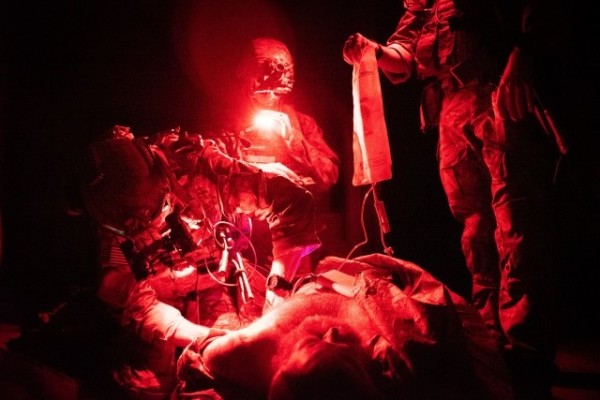

We already knew that Army Rangers were a unique breed of badass, but performing real-time blood transfusions while under enemy fire on the battlefield takes it to an entirely new level.
The Ranger O Low Titre Program (ROLO), developed a few years ago, allows soldiers to donate blood to their wounded comrades on the battlefield in a matter of minutes, according to a recent Army press release.
“When called upon, a blood donor volunteer moves to the casualty and pulls out their issued blood donor pack,” the release explains. “Either the unit’s combat medic or a trained non-medic Ranger draws the blood from the volunteer. The volunteer then returns to combat and the blood is immediately administered to the casualty.
“The whole process takes about 10 minutes.”
Rangers in Afghanistan saw this life-saving technique executed in combat for the first time last summer, according to the release, when an assault force was pinned down for two hours in Wardak province during a night raid.
During the fight, three Rangers were wounded in an initial blast; one critically-wounded casualty was pulled out of the line of fire (marginally — the only cover available was “a small lump of earth no more than one meter high,” the release said), and began being assessed by combat medic Staff Sgt. Charles Bowen from Bravo Company, 1st Battalion, 75th Ranger Regiment. Sgt. Ty Able, also from Bravo Company, began checking out the other two Rangers.
Bowen found that his casualty had a “gaping hole on the right side of his chest,” with a weakening pulse. While helping him, another Ranger stumbled over to Bowen, blood pouring from his neck. Bowen immediately moved to stop the bleeding, applying pressure to the neck wound and eventually performing with Able a cricothyroidotomy to help him breath — an incision in the neck to establish an airway.
All of this was being done while taking machine gun and mortar fire.
After getting the neck wound under control, Bowen turned back to the casualty with the chest wound, who was bleeding out. There were no more available blood units, as they’d all been used.
That’s when Bowen and Able turned to ROLO — three different times, while under direct enemy fire. They drew fresh blood from pre-screened donor volunteers, all with universal type O blood, transferring it to the wounded casualties. In 2017, the ROLO Whole Blood Program was awarded the Army’s Greatest Innovation Award by Army Materiel Command.
The two medics also covered their patients with their own bodies to protect them from the chaos unfolding around them.
“As all of the treatments and movements while under enemy fire were occurring, danger close fire missions with hellfire missiles, 30mm rounds, and 105mm rounds were being executed as close as 30 meters from our position,” Bowen said in the release. “As this was happening, Sgt. Able and I did our best to shield our casualties from harm and covered their ears during impact of the large munitions.”
Bowen and Able ultimately saved six lives the night of the raid — including the Ranger who received blood transfusions on the battlefield.
Lt. Col. Ryan Knight, M.D., 75th Ranger Regiment Command Surgeon, said in the release that every “link in the system worked that night” to save lives.
“Rangers train casualty care every day, leaders train to handle casualties, and our medics take pride in being the world experts in tactical combat casualty care,” Knight said in the release. “While this is an amazing display of personal courage, medical expertise, and the most incredible saves I’ve ever heard of, it’s also Rangers living the Ranger Creed and is what we expect every day from the 75th Ranger Regiment.”